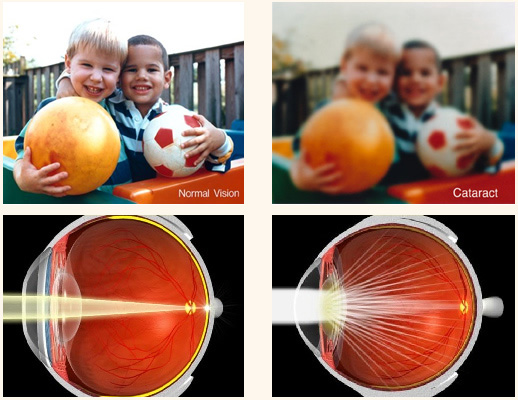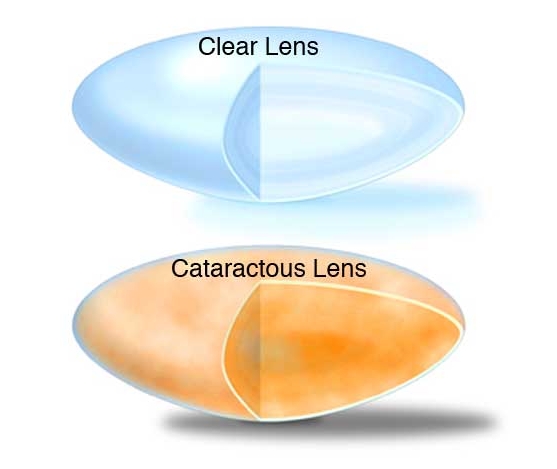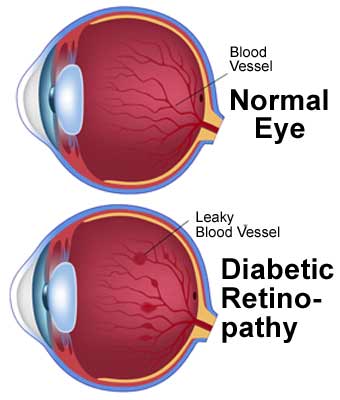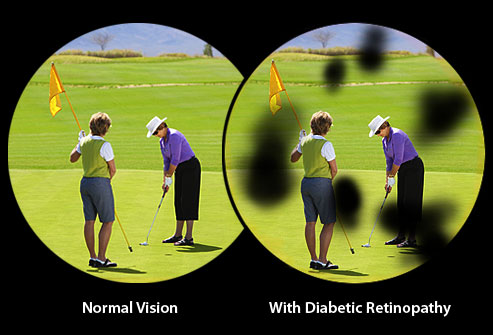Cataracts
A cataract is the term used for when the natural lens in the eye grows cloudy enough to affect your vision. This clouding process is very common and is mostly related to aging. The National Eye Institute reports that by the age of 80 more than half of all Americans will have developed cataracts or had cataract surgery.
There are other causes of cataracts other than aging. A secondary cataract is a one that has formed after surgery or from other eye problems such as glaucoma. Babies can be born with congenital cataracts that may or may not affect vision. Lastly cataracts can be formed by exposure to radiation, trauma, and steroid use.


These cataracts all affect your vision in the same manner to create dimmed or blurry vision. When light enters the eye through your cornea, it is focused by your lens onto the retina to produce a clean and sharp image. When that lens is clouded the light will bounce and scatter when passing through the lens. This scattered light does not hit the retina as uniformly as before and the result is blurred vision or dimmed vision.
During our exams, Dr. O'Connor will dilate your pupils to give her a clear view of the lens in your eye along with measuring your refractive error. This will help to determine if you have cataracts and the degree of their cloudiness. While Dr. O'Connor does not perform surgeries, she is committed to providing the best eye care for her patients. Working closely with many other ophthalmologists, Dr. O'Connor will be able to refer you to the proper surgeon for any of your needs.
Diabetes
Diabetes is a deadly disease that affects your blood sugar. This disease can cause heart disease, kidney failures and even vision loss. The good news is that diabetes can be controlled and managed with proper eye care before problems like vision loss begin to occur. Most diabetics can live normal and healthy lives with a healthy diet and appropriate exercise. The National Eye Institute recommends diabetics have an annual diabetic eye exam.


Diabetic eye disease can include Cataracts, Glaucoma and Diabetic Retinopathy. Diabetic Retinopathy is the leading cause of blindness in American adults. Diabetic Retinopathy is when your blood sugars start to negatively affect your blood vessels in your eyes. The sugar in your blood tears up and weakens the cell walls that make up your blood vessels. The result is a leak or ooze of fluid from those vessels. As these structures grow weak, the body reacts by trying to grow new blood vessels. However these new vessels are not structurally sound as they grow and they too leak and ooze. All these leaky vessels ooze, the fluid builds up on the retina and suffocates it, resulting in vision loss.
Generally there are no symptoms leading up to Diabetic Retinopathy. There is no pain associated and your vision may not be affected until the disease is at severe stages. This is why continuing to have annual exams despite changes in vision is key to effectively managing your health as a diabetic.
Dr. O'Connor does not perform surgeries or laser procedures for Diabetic Retinopathy but she is committed to providing the best eye care for her patients. Working closely with many ophthalmologists, she will be able to refer you for any procedure or surgery you may need.
Glaucoma
Glaucoma is defined as a disease that affects the optic nerve and results in progressive vision loss. The optic nerve is the large bundle of over 1 million nerve fibers that connects your eyes to your brain. The loss of these fibers over time directly corresponds to loss of vision. With early detection and preventative eye care, Glaucoma can be effectively managed to help prevent severe vision loss.

Studies show that high intraocular pressure, the pressure inside the eyeball, is a major risk factor for Glaucoma. Towards the front of our eye is a space called the anterior chamber, where a nourishing fluid sustains nearby tissue. This fluid flows through the chamber, and exits through a mesh work at an angle, where the cornea and iris meet. In open angle glaucoma, the fluid has trouble draining through the mesh work and the fluid builds up. This build up causes the pressure inside the eye to spike and this high pressure damages the optic nerve, resulting in vision loss. In some cases, the angle that the fluid drains out of is too narrow, and results in closed angle glaucoma. If the angle is too narrow and the pressure spikes a person may feel nausea and pain; this is a medical emergency.

The demographics at highest risk for this disease are African Americans over 40, Mexican Americans over 60 and those with a family history of glaucoma. There is no cure for Glaucoma but there are eye drops that are effective at lowering the pressure in the eye thus reducing risk of vision loss. There are those that are born with congenital glaucoma, and also those who have lost vision even though they have normal pressures (low-tension).
Dr O'Connor does not perform surgeries or procedures for glaucoma, but she is committed to her patients eye care. Working closely with many ophthalmologists, she will be able to refer you for any procedures or surgeries that you may need.
Macular Degeneration
Macular Degeneration or Age related Macular Degeneration (AMD) is a common disease and the leading cause of vision loss in Americans age 50 and over. The degeneration damages the macula, a small dip near the center of the retina that focuses your fine central vision. This small spot is responsible for your sharp focused image, while the rest of your retina is responsible for your peripheral vision. While AMD does not lead to complete loss of vision or blindness, the loss of your central vision can severely debilitate your ability to do everyday things like reading, writing and driving.

There are three stages of AMD, early, intermediate, and late. These stages are largely diagnosed by the number and size of drusen. In the early stages, the drusen are typically medium sized, and patients do not report vision loss. Intermediate AMD is characterized by large drusen, retinal pigment changes or both and while vision loss is possible, it is not widely reported. In the late state of AMD, in addition to drusen, patients have vision loss. The late state is split into geographic AMD and neovascular AMD. Geographic AMD is referred to as "Dry" and is the result of light sensitive cells in the macula breaking down resulting in vision loss. Neovascular AMD is referred to as "Wet" because new blood vessels begin to grow, and as they are not structurally sound begin to leak fluid and blood onto the macula. This can cause swelling and damage, and patients often report a shimmer effect that feels like they are looking through glass, or water. If you are experiencing any of these symptoms, see your eye care specialist as soon as possible!

Older Caucasians, those who smoke, those with poor nutrition and those who do not wear sun protection are at the most risk for developing AMD. While there is no cure for for AMD there are many treatments to help slow the loss of vision, and preventative vitamins to take that reduce the risk. Dr O'Connor does not perform surgeries or procedures, but she does work closely with many ophthalmologists and will refer you for any surgery or procedure you may need.

